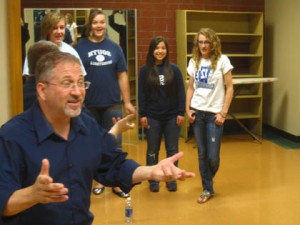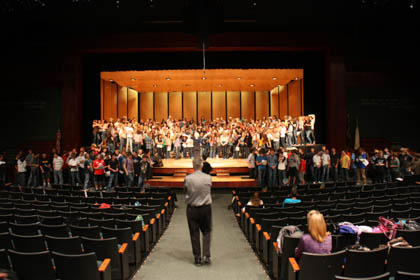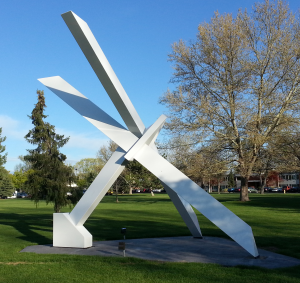On Interpreting Abstract Public Art
A visitor approached me early last Fall, and asked “…so what’s that supposed to be?” pointing out the massive Rod Kagen sculpture we’d recently installed outside.
I jumped into docent mode, rattling off the name of the piece, “42 (Birthday Series),” the artist, a little bit on where it came from, and so forth. Seeing this information obviously was not sufficient, I paused a moment, then said, “What do you think it is?”
Full disclosure–I’m a generalist, my background is in music, and the “art is what you think it is” retort was perhaps a bit of a cop-out. But the oft-used phrase is sometimes a legitimate attachment point for artists–particularly abstract artists. What followed, however, was a very cordial but brief conversation, the substance of which could be boiled down to the visitor having a respect for artists in general, but also having an apologetic failure to understand or connect with this piece in particular.
These exchanges are not uncommon among curators and public administrators. Part of the difficulty of abstract public art is that a percentage of the public has had very little if any formal, or even rudimentary training in art appreciation and criticism. I fear that percentage may be large. With the current focus on “we need more students excelling in STEM fields,” and “Common Core will save our public schools” (it will not, but that’s a blog for another day), the percentage will only increase.
Whatever the artist’s intent in a piece, in abstract works that intent is often “lost in translation.” If there is a thematic symbolism in the work, that symbolism is lost. If a work’s intent is much more aesthetic in nature, the viewer often does not have enough context to grasp that aesthetic, and formulate either a positive or negative impression of it. This is saddening, not only for the lost opportunity on the part of the artist, but for the broader comment this makes on society’s value of art as a whole.
We are blessed to have another Kagen piece in the same sculpture park,an iconic totem from his “Tapered Column” series. The piece was donated to the University in the memory of a former president, Leon Doane, who served a brief year before dying of cancer. Doane was an impressively-statured man who made a huge impact in his short time as President. When people ask about the tall, impressive sculpture, I relate the story of Doane and the reason behind the work’s donation. I have yet to find a person so informed–whether they are familiar with the University or not–who hasn’t instantly made an emotional connection with the piece.
Here’s at least one great power of abstract art; the context around it can assign meaning beyond that which the artist even intended. I’m not suggesting every abstract piece of art needs it, but in this case the idea of the man creates an alternate path to appreciation. That appreciation may lead to more time spent contemplating the piece, and more emotional and conceptual connections made.
Our task in curating public art lies in helping people to make those connections. Sometimes a plaque with a single word will suffice. Other times it requires more effort. Personally I think we have our work cut out for us in advocacy for the arts and arts appreciation–and not just in the schools, mind you. We need to figure out how to connect with our existing communities, all the while working hard to advocate so those connections will be easier to make for our future generations.
This, so at some point in the future, a passerby might pause to look at “42 (Birthday Series),” and be able to take something away from the experience.
I’m not saying people don’t now–but more people should. What do you think?
 The audience–with a good number of parents, but predominantly full of teens–would get quiet enough to hear a pin drop when the groups were performing. Such attention and respect is often only seen in far more “formal” concert settings like a Boise Philharmonic concert. But in this case, as each of the groups finish, the audience would explode in applause and cheers, often far louder than the music that preceded it.
The audience–with a good number of parents, but predominantly full of teens–would get quiet enough to hear a pin drop when the groups were performing. Such attention and respect is often only seen in far more “formal” concert settings like a Boise Philharmonic concert. But in this case, as each of the groups finish, the audience would explode in applause and cheers, often far louder than the music that preceded it. have it figured out. They’ve taken the highly exacting competitive experience of Barbershop ensemble competition (if you haven’t actually attended a
have it figured out. They’ve taken the highly exacting competitive experience of Barbershop ensemble competition (if you haven’t actually attended a  One student commented, “I learned more today than I learned in a year in school.” That’s the “drinking from a firehose” experience of learning from good clinicians. That learning is multiplied when kids are excited–and see so many of their peers equally excited–about the experience. The festival/clinician experience doesn’t replace a great in-school arts curriculum, but can really give local teachers a boost.
One student commented, “I learned more today than I learned in a year in school.” That’s the “drinking from a firehose” experience of learning from good clinicians. That learning is multiplied when kids are excited–and see so many of their peers equally excited–about the experience. The festival/clinician experience doesn’t replace a great in-school arts curriculum, but can really give local teachers a boost.

